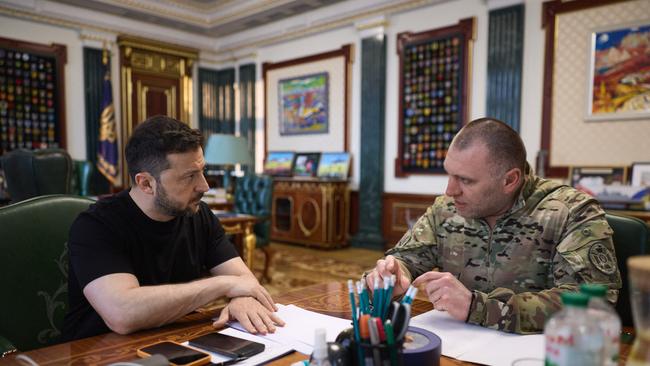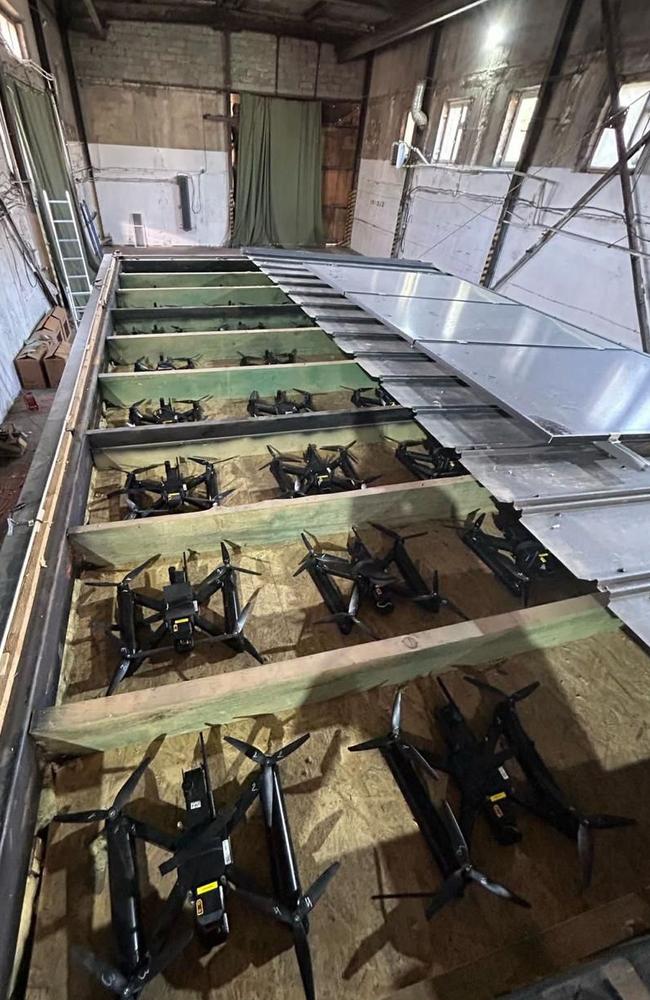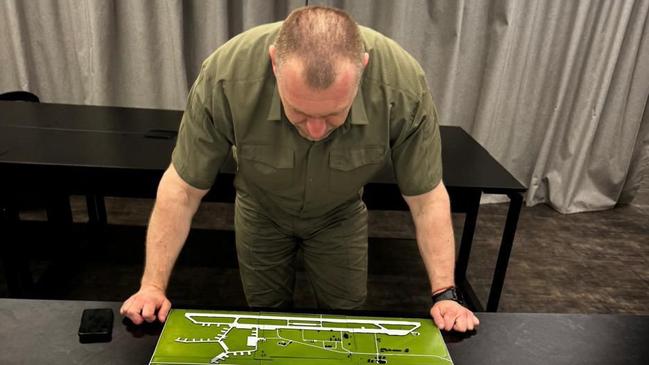Ukraine drone attack on Russia: How FPV drones helped pull off attack
Ukraine’s mass drone attack on Russia was largely carried out with a sophisticated use of artificial intelligence. This is how they did it. SEE THE VIDEO
World
Don't miss out on the headlines from World. Followed categories will be added to My News.
A massive Ukrainian drone strike on Russian air bases — already being compared to a ‘Pearl Harbor’ moment by pro-Kremlin bloggers — marks one of the most far-reaching attacks of the war.
President Volodymyr Zelensky confirmed the operation, code-named Spider’s web - claiming that more than a third of Russia’s strategic cruise missile carriers were hit.
The scale and precision of the assault has stunned Russian commentators, with some pro-Moscow military bloggers comparing the strike to a “Russian Pearl Harbor”.
Here’s everything we know about the attack so far.
WHAT HAPPENED?
Mr Zelensky said it deployed 117 drones in a massive attack against Russian air bases that he called “our most long-range operation” in more than three years of war.
“A total of 117 drones were used in the operation. And a corresponding number of drone operators worked,” Ukraine’s President said in a statement, adding that “34 per cent of the strategic cruise missile carriers at the airfields were hit”.

Mr Zelensky also said agents involved in preparing the drone strikes had been “withdrawn” from Russian territory in time, after Russia’s defence ministry said several “participants” had been arrested.
Russian bombers worth billions of dollars were destroyed in the “large-scale” drone assault as Ukraine geared up for talks with Moscow counterparts to explore prospects for a ceasefire.
In a spectacular claim, Ukraine said it damaged $US7 billion ($A11bn) worth of Russian aircraft parked at four air bases thousands of kilometres (miles) away, with unverified video footage showing aircraft engulfed in flames and black smoke.
WHERE DID THE ATTACKS TAKE PLACE?
HOW DID THE ATTACKS TAKE PLACE?
A source in the Ukrainian security services (SBU) said the strikes hit 41 planes that were used to “bomb Ukrainian villages”.
The drones were concealed in the ceilings of transportation containers which were opened up to release them for the assault, the source added.
TU-95 “Bear” nuclear bombers, TU-22 “Backfire” fast-attack bombers and A-50 “Mainstay” command-and-control jets were among the aircraft that were destroyed in the strike, according to reports.
The attack took around 18 months of planning, Kyiv said.
WHAT KIND OF DRONES DID UKRAINE USE?
According to AP, first-person view (FPV) drones were smuggled into Russia via trucks, where they were then placed into mobile wooden kit houses to launch the attacks.
Ukraine has long struggled to target the Russian bombers used to launch mass missile attacks on its cities. Moscow has kept those aircraft out of range of both Ukraine’s own weapons and those supplied by its Western allies.
Using FPV drones in this way would mark the latest evolution in the still-young and rapidly changing world of drone warfare.
The attack was also likely highly cost-effective - FPV drones can cost as little as a few hundred dollars each, while the value of 41 heavy bombers runs into the billions.

WHAT ARE FPV DRONES?
AI-powered First Person View (FPV) drones are unmanned aerial vehicles carrying artificial intelligence that help them perform tasks.
In learning how to process real-time video data through AI algorithms, FPV drones can avoid obstacles and carry out surveillance, search and rescue.
They offer users a ‘First Person View’ of the flight in their live video feed and the entire system, developed by Ukraine’s defence department Brave1, can deliver two AI-guided FPV strike drones with a range of up to 300km, according to The Kyiv Independent.
Once released, smaller drones can autonomously locate and hit high-value targets, including aircraft and infrastructure without using GPS and any human involvement.
Without GPS, this means the drone overcomes issues with signal loss or jamming from an enemey target.
It also has an in-built smart pilot system that uses advanced camera data to help pinpoint where it will need to strike its target. This can all be seen on its live video feed.
WHY IS IT BEING CALLED RUSSIA’S PEARL HARBOUR?
Pro-Moscow military bloggers are calling the strike “the Russian Pearl Harbor” — in reference to the Japanese attack against the US in 1941 that prompted Washington to enter the Second World War.
Moscow is expected to retaliate, with speculation already appearing online about whether President Vladimir Putin will again threaten the use of nuclear weapons.
“We hope that the response will be the same as the US response to the attack on their Pearl Harbor or even harsher,” military blogger Roman Alekhin wrote on his Telegram channel.
WHAT DID THE US KNOW?
According to the New York Post, Ukraine did not give the Trump administration advance notice of the swarm of drone strikes that wiped out dozens of nuclear “doomsday” bombers and other aircraft.
The daring Ukrainian operation had been in the works for more than a year, but the White House was not given a heads-up that the planned attack was coming, CBS and Axios said, citing sources.

HOW MANY STRATEGIC BOMBERS DOES RUSSIA HAVE?
Russia’s A-50 “Mainstay” command-and-control jets provide several critical functions for the ongoing war in Ukraine, such as detecting air defence systems, guided missiles, and co-ordinating targets for fighter jets.
Russia possesses fewer than 10 of these planes. A-50 aircraft have an estimated price tag of around $US350 million ($A542.5m).
The Tupolev Tu-95, the Tupolev Tu-22, as well as the Tupolev Tu-160, are all Russian heavy bombers regularly used to launch missiles at Ukrainian cities.
The Tu-95 is the oldest of the three aircraft, a Soviet-era plane that made its first flight in 1952. It was originally used to carry nuclear bombs but has since evolved to launch cruise missiles.
Each aircraft can carry 16 cruise missiles – either the Kh-55/Kh-555 or the newer Kh-101 and Kh-102 air-launched cruise missiles.
WHAT NEXT FOR RUSSIA AND UKRAINE?
The long-planned operation came at a delicate moment three years into Russia’s invasion.
Mr Zelensky said Sunday that he was sending a delegation to Istanbul led by his Defence Minister Rustem Umerov for talks on Monday with Russian officials.
Turkey is hosting the meeting, which was spurred by US President Donald Trump’s push for a quick deal to end the three-year war.
Mr Zelensky, who previously voiced scepticism about whether Russia was serious in proposing Monday’s meeting, said priorities included “a complete and unconditional ceasefire” and the return of prisoners and abducted children.
Russia, which has rejected previous ceasefire requests, said it had formulated its own peace terms but refused to divulge them in advance.
Russian Foreign Minister Sergei Lavrov and his US counterpart Marco Rubio spoke by telephone Sunday about “several initiatives aimed at a political solution to the Ukraine crisis”, including Monday’s talks, the Russian foreign ministry said in a statement carried by the TASS news agency.
- with AFP
More Coverage
Originally published as Ukraine drone attack on Russia: How FPV drones helped pull off attack





